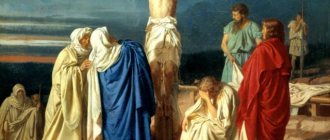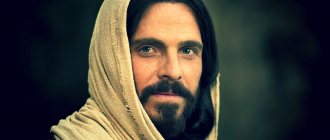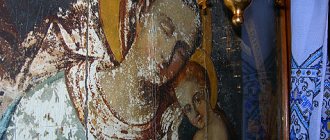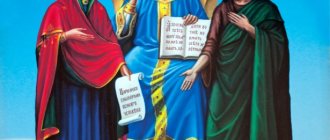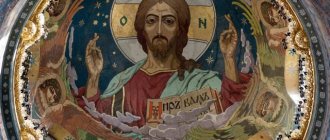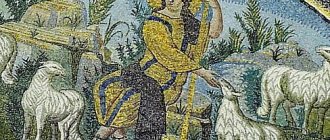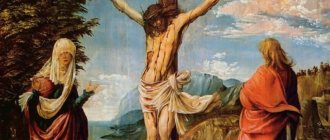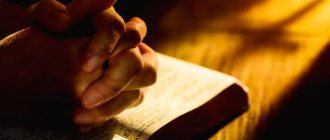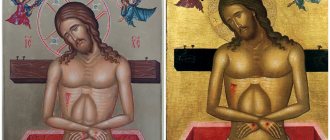Icon "Christ the Vine"
The extraordinary icon “Christ the Vine,” dedicated to the image of the Savior, is the most holy image that helps in any troubles and misfortunes.
The image of Christ "The Vine" is a symbol of wisdom and prosperity. This icon is famous among Christians and has special reverence and respect. A huge number of believers offer their prayers before the miraculous image, which contains enormous divine power that can help in life’s difficulties and sorrows.
History of the icon “Christ the Vine”
The appearance of the image dates back to the 15th century. The first icon was painted by a monk who served at one of the monasteries in Greece.
As already mentioned, this icon symbolizes sanity of mind, prosperity and well-being. The Orthodox image is called “The Grapevine” for a reason, for in the Gospel itself the Savior is repeatedly called that way.
For Orthodox believers, the icon quickly became one of the most revered and beloved holy images. Many Christians from all over the world pray before the miraculous face, which always helps true believers.
Where is the miraculous image of the Savior “The Grapevine” located?
The glorified face of Christ, which is often called the “True Vine,” is a rare and unique icon that is not found in churches in every country. In Russia, the shrine can be found in the following holy monasteries:
- Moscow, “Temple in the Name of the Icon of the Blessed Virgin Mary”;
- St. Petersburg, Church of the Savior on Spilled Blood.
Description of the icon
There are several options for writing the most holy image of Christ “The Vine”. But only two of them are considered the most common and beloved by Orthodox believers.
A later version of the icon depicts Jesus among a spreading vine. Many branches unravel from it, where the Mother of God is located, and with her St. John and the other great apostles. Thus, the icon directly depicts words from the Gospel.
Another, no less famous image depicts the Savior, but the plot deviates from the texts of Holy Scripture. In the divine hands of Jesus, life sprouts in the form of a vine, from which He squeezes the juice onto the sacred Chalice for Communion.
What do they pray for before the miraculous image?
This shrine can help believers in any trouble and in various life difficulties. But Orthodox people more often offer their prayers before the image of the Savior “Christ the Vine” with requests:
- about getting rid of fears, vices and depressing thoughts;
- about salvation from evil intentions, enemies and enemies who want suffering;
- about maintaining family happiness, harmony and getting rid of quarrels;
- about good health, strong faith and good, sincere thoughts and actions;
- about maintaining peace of mind.
Days of celebration
There is no official date for the celebration of this image of Christ in the calendar of the Russian Orthodox Church. Many believers set aside one day a year for glorification and special veneration of the icon - May 29.
Prayer before the holy icon “Christ the Vine”
“Oh, Great Savior, true son of the Lord! We turn to You in the words of our prayer asking for help and support in difficult times! Shelter from troubles and sorrows, protect from quarrels and discord in the family! Take the enemies away from our homes and heal our sinful souls. Guide me on the righteous path and do not let me stray from the right path. Only You are able to help us, O our Holy Guardian! We will not stop glorifying Your name! Let Your will be done! Forever and ever. Amen".
Only true believers in the power of the Lord and the miraculous abilities of the holy icon can receive the support and protection of Christ. Offer the words of prayer with pure thoughts and from the depths of your heart, then your life will certainly change for the better, and troubles will pass you by. We wish you peace in your soul, and do not forget to press the buttons and
Grapes in ancient times. Meaning and symbolism
Disputes continue among historians about which plants became man's first companions in settled life: root crops, cereals, vegetables. However, the inhabitants of the Mediterranean have no doubt - the first cultivated plant is the grapevine. Since ancient times, the warm climate and soil characteristics of a number of Mediterranean regions provided optimal conditions for growing grapes, and the ability to harvest from one vineyard for years gave a certain stability to sedentary farmers, for whom wine was both a food product and a factor of survival.
Ancient Egyptian papyri brought to us several legends about the grapevine from which the healing drink was made. Grapevines with clusters are present in paintings and carved stone images of tombs of both the highest nobility and priests, and the middle classes.
Vintage. Ancient Egyptian fresco
The vine, grape berries and wine occupy an important place in the culture and art of antiquity. Wreaths of leaves, bowls raised in friendly toasts, ornaments of intertwining vines - grape motifs permeate the architectural and artistic monuments that have come down to us. The ancient Greek and then the ancient Roman pantheon included gods, one way or another connected with wine and winemaking - Dionysus, Bacchus, Bacchus. No other product has received individual divine patrons.
Vintage. Antique mosaic
The importance of wine for ancient civilizations was based not only on the pleasant taste and intoxicating effect of wine, wine acquired a sacred meaning, becoming an obligatory drink during celebrations, a kind of guide to the world of illusions and fun. Wine symbolized the joy of life and well-being.
On the other hand, wine was a symbol of wisdom. A person who knew how to stop drinking an alluring drink had, in the eyes of the ancients, inner strength worthy of respect. And inappropriate behavior while intoxicated was attributed to divine forces that took possession of a person. The famous Latin saying “In vino veritas” - “Truth is in wine” - is still one of the frequently quoted aphorisms today.
Red wine also symbolized blood. The replacement of bloody rituals that required human sacrifices with mysteries in which wine was used instead of blood was a step in the development of humanistic philosophy, which predetermined the emergence and development of ancient civilization.
Lord have mercy.
1 Blessed is the man who does not walk in the counsel of the wicked, nor stand in the way of sinners, nor sit on the seats of the destroyers, 2 but his will is in the law of the Lord, and in His law he shall learn day and night. 3 And it shall be like a tree planted by the rising of the waters, which shall yield its fruit in its season, and its leaf shall not fall off, and all that he createth shall prosper. 4 Not like wickedness, not like this, but like dust that the wind sweeps away from the face of the earth. 5 For this reason the wicked will not rise again for judgment, below the sinner for the council of the righteous. 6 For the Lord preaches the way of the righteous, and the way of the wicked shall perish.
Story PRAYER
The village of Strugi, where Father Anatoly lives, is quiet, poor, log-built and famous only throughout the entire district for its dense lilac gardens. A long time ago, some passer-by assured the women that the lilac tree protects from all pestilence, so they welcomed this tree into their home and allowed it to unfold from edge to edge.
During the lilac season the village is not visible. If you look at it from a distance, you will see one thick purple cloud lying on the ground.
At this time I spent the night with Father Anatoly. Our scholars and scholars consider him a “wretched priest,” since he is poor in intelligence, has little education, is unpretentious in appearance, and his sermons are awkward, like peasant speech.
“But he believes in God so much,” those who loved him said in response, “that he can perform miracles!”
They assured me almost with an oath: when Father Anatoly prays, the lamps and candles light up by themselves! The windows of the priest's upper room were open to the garden, to the white night, all in lilacs, dawns and nightingales. Father Anatoly was sitting on the windowsill and turned in my direction several times, apparently waiting for me to fall asleep. I pretended to be asleep. Father Anatoly took off his shabby patched cassock and put on a white one, from under which the peasant's tar boots were visible. He was preparing for something. Combing his dusty reddish beard and the same hair with a comb, his hand trembled. It seemed to me that a spasm passed over his rough peasant face and thoughtfulness lay between his thick eyebrows.
I am the true vine
I am the true vine, and My Father is the vinedresser. Every branch in me that does not bear fruit He cuts off, and every branch that bears fruit He purges, so that it may bear more fruit” (John 15:1-2).
Our Lord and God Jesus Christ calls Himself the Vine, and calls us all branches of this vine. Listen further to what He says: “You have already been cleansed through the word that I preached to you. Abide in Me, and I in you. Just as a branch cannot bear fruit by itself unless it is in the vine, so neither can you unless you are in Me.”
This is clear to you, it is quite clear that a branch that has not retained the connection with its vine, of course, cannot bear fruit.
Contents of the icon
Also, this image is often called the grapevine icon, since here the grapevine tree, which represents the church, is used as a symbol.
In the center is Spas, which is like the base of the vine. Various branches branch off from it, and these branches are the apostles, the Virgin Mary and other gospel characters.
Considering the Tree of Life icon , its meaning becomes completely clear: the church is a semblance of a living organism that includes an entire community. Of course, it begins with a relatively small number of people: Christ himself and the holy ascetics. However, the church then begins to consist of the community of all Christians, that is, all people of this faith constitute the so-called body of Christ.
People in the church are united with each other, they are interconnected like ampelos (grapevine in Greek) and everyone can act in one way or another. For example, the one who chooses a heavenly existence is raised by his own branch upward and reaches the limit of Heaven. Anyone who, on the contrary, strives for nothing, becomes a dry branch, which is eventually separated from the tree in order to be burned.
In addition, the icon of the Tree with Christ gives a hint of the family tree, which represents the genealogy of each individual person.
Only in this image is a family understood as a Christian church and community in which people are related to each other.
This is the property of Christianity, which erases any boundaries and differences between people and allows everyone to enter the Kingdom of God.
The meaning of the Tree of Life icon indicates the opportunity for a believer to better understand his own involvement in the church. Before this image, any prayers are offered to Christ. It is also possible to pray to the Holy Trinity or the Holy Spirit in front of this image.
History of appearance
Some believers do not know anything about this icon. Therefore, before you pray to her, you need to become more familiar with the history of her appearance. This image was written on a huge board with a point at the top. The image was made to order, which came from a monastery located in the town of Monticelli.
For many years, historians could not determine the author of the Tree of Life (Mountain Jerusalem) icon. Initially, art historians attributed the work on the painting to Pacino di Buonagvida. However, this theory was quite controversial, as many historians doubted it. For example, according to Bernard Berenson, the author of the work was Wimbria. At the same time, Pietro Toesca argued that it was written by masters of the Giottian school.
A lot of research has been carried out to determine the author of the icon. At first they did not bring any results, but over time it was proven that the picture was painted by Pacino di Buonagvida. This theory is also confirmed by the fact that the icon contains traces of the influence of the Bolognese and Rome art schools. The exact date of creation could not be determined. Despite this, historians suggest that it was created between 1305 and 1310.
It was during this period of time that the famous preacher Ubertino was in Florence, who spoke a lot about Jesus. This monk’s treatise inspired the artist to paint the picture. The theme of the Tree of Life was revealed in detail in the preacher’s work. The monk described it in very detail and unusually, connecting everything with Christ and his life. The text in the work is divided into twelve parts and forty-eight chapters. The artist tried to depict a piece of information from each chapter in his painting The Grapevine.
Icon of the Tree of the Blessed Virgin Mary
Compositionally, this option is practically no different from the previous one, but here the basis is the Tree of the Virgin Mary. In the center there is a scene of the birth of Christ, and on the branches there are various images of the Blessed Virgin.
The name of the icon “Mountain Jerusalem” is also used, which indicates the resurrection and the opportunity for every believer to find himself in the Heavenly Jerusalem. To do this, you just need to keep the commandments on earth. Then, after the end of times, the righteous will ascend there. The Heavenly City itself is depicted on one of the edges of the image, hidden behind a haze.
You should also consider the meaning of the icon of Mount Jerusalem, where the central part is occupied by the scene of the birth of the Savior. This event focuses attention and is central in every sense, only thanks to this the rest became possible. On the branches there are various images of the Virgin Mary with the baby; they invite the believer to look at different variations of the relationship between the Mother of God and the baby.
Also symbolically, this diversity indicates various options for the relationship between the believer and the Lord. The soul strives for the Lord in different ways and establishes a whole range of relationships. It was thanks to the birth of Christ that these relationships became not only possible, but also make it possible to gain the Kingdom of Heaven.
As a rule, prayer to the icon of the Tree of the Blessed Virgin Mary is said in solitude. Therefore, a small space in the house is often set aside for this, which allows you to move a little away from the hectic world and turn to the image. Each image that contains the icon of the Tree of the Virgin Mary helps in something separate.
Therefore, prayer in front of this icon can be used to receive a wide variety of benefits.
What do they ask for before the holy face?
People who are going to pray in front of the Tree of Life should figure out in advance what they can ask for in front of this icon. Priests recommend seeking help from the holy face in times of physical or spiritual weakness in order to gain strength.
It is also necessary to pray in front of the Tree of Life in the following cases:
- Protecting children and relatives from committing rash acts.
- A request for intercession from ill-wishers and envious people.
- Finding comfort in times of grief.
- A request for help in healing the soul and body.
- Repentance for sins committed.
- A request to protect the family home from possible conflict situations or other troubles.
You must read the prayer text with pure thoughts and sincere faith in the Lord. The words of the prayer service must be pronounced thoughtfully and clearly, without being distracted by anything.
Prayers before the icon of the Tree of the Virgin Mary
Prayer 1
My Blessing Queen, my hope, Mother of God, Friend of the orphans and the strange, the Representative of the sorrowing, the Joy of the offended, the Patroness! See my misfortune, see my sorrow, help me as I am weak, feed me as I am strange. Weigh my offense, resolve it as if you will: for I have no other help except You, no other Representative, no good Comforter, only You, O Mother of God, for you will preserve me and cover me forever and ever. Amen.
Prayer 2
O Most Holy Virgin, Mother of the Lord Most High, Intercessor and Protector of all who resort to You! Look down from Thy holy height upon me, a sinner (name), who falls before Thy most pure image; hear my warm prayer and offer it before Your Beloved Son, our Lord Jesus Christ; beg Him to illuminate my gloomy soul with the light of His Divine grace, to deliver me from all need, sorrow and illness, to grant me a quiet and peaceful life, physical and mental health, to pacify my suffering heart and heal its wounds, to guide me for good deeds, may my mind be cleansed from vain thoughts, and having taught me to fulfill His commandments, may He deliver me from eternal torment and may He not deprive me of His Heavenly Kingdom. O Most Holy Theotokos! You, “Joy of all who mourn,” hear me, the sorrowful one; You, called “Quenching of Sorrow”, quench my sorrow; You, “Burning Kupino”, save the world and all of us from the harmful fiery arrows of the enemy; You, “Seeker of the Lost,” do not allow me to perish in the abyss of my sins. According to Bose, all my hope and hope is in Tyabo. Be a temporary Intercessor for me in life, and an Intercessor for eternal life before Your Beloved Son, our Lord Jesus Christ. Teach me to serve this with faith and love, and to reverently honor You, Most Holy Mother of God, Most Blessed Mary, until the end of my days. Amen.

